Biol 186 uvic - Study guides, Class notes & Summaries
Looking for the best study guides, study notes and summaries about Biol 186 uvic? On this page you'll find 37 study documents about Biol 186 uvic.
Page 3 out of 37 results
Sort by
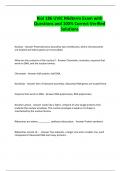
-
Biol 186 UVIC Midterm Exam with Questions and 100% Correct Verified Solutions
- Exam (elaborations) • 10 pages • 2024
- Available in package deal
-
- $12.99
- + learn more
Biol 186 UVIC Midterm Exam with Questions and 100% Correct Verified Solutions
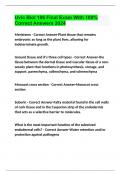
-
Uvic Biol 186 Final Exam With 100% Correct Answers 2024
- Exam (elaborations) • 7 pages • 2024
- Available in package deal
-
- $12.49
- + learn more
Uvic Biol 186 Final Exam With 100% Correct Answers 2024
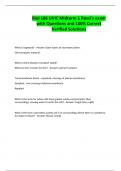
-
Biol 186 UVIC Midterm 1 Rossi's exam with Questions and 100% Correct Verified Solutions
- Exam (elaborations) • 9 pages • 2024
- Available in package deal
-
- $12.79
- + learn more
Biol 186 UVIC Midterm 1 Rossi's exam with Questions and 100% Correct Verified Solutions
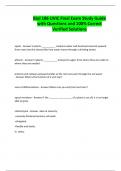
-
Biol 186 UVIC Final Exam Study Guide with Questions and 100% Correct Verified Solutions
- Exam (elaborations) • 8 pages • 2024
- Available in package deal
-
- $12.79
- + learn more
Biol 186 UVIC Final Exam Study Guide with Questions and 100% Correct Verified Solutions
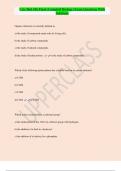
-
Uvic Biol 186 Final (Campbell Biology) Exam Questions With Solutions
- Exam (elaborations) • 34 pages • 2024
-
- $22.49
- + learn more
Uvic Biol 186 Final (Campbell Biology) Exam Questions With Solutions Organic chemistry is currently defined as a) the study of compounds made only by living cells. b) the study of carbon compounds. c) the study of natural compounds. d) the study of hydrocarbons. b) the study of carbon compounds. Which of the following hydrocarbons has a double bond in its carbon skeleton? a) C3H8 b) C2H6 c) C2H4 d) C2H2 c) C2H4
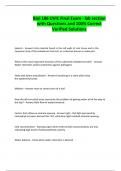
-
Biol 186 UVIC Final Exam - lab section with Questions and 100% Correct Verified Solutions
- Exam (elaborations) • 6 pages • 2024
- Available in package deal
-
- $12.99
- + learn more
Biol 186 UVIC Final Exam - lab section with Questions and 100% Correct Verified Solutions
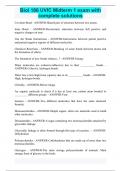
-
Biol 186 UVIC Midterm 1 exam with complete solutions
- Exam (elaborations) • 6 pages • 2024
-
- $10.49
- + learn more
Covalent Bond Shared pair of electrons between two atoms. Ionic Bond Electrostatic attraction between full positive and negative charges on ions. Previous Play Next Rewind 10 seconds Move forward 10 seconds Unmute 0:00 / 0:15 Full screen Brainpower Read More Van der Waals Interactions Interactions between partial positive and partial negative regions of different molecules. Chemical Reactions Breaking of some bonds between atoms and the formation of others....
Bundle of Biol 186 UVIC Exams All with Questions and Correct Verified Answers

-
UVic Biol 186 Final (Campbell Biology) Exam Study Questions and Answers with Complete Solutions 2024
- Exam (elaborations) • 17 pages • 2024
- Available in package deal
-
- $14.99
- + learn more
Organic chemistry is currently defined as a) the study of compounds made only by living cells. b) the study of carbon compounds. c) the study of natural compounds. d) the study of hydrocarbons. - b) the study of carbon compounds. Which of the following hydrocarbons has a double bond in its carbon skeleton? a) C3H8 b) C2H6 c) C2H4 d) C2H2 - c) C2H4 Which action could produce a carbonyl group? a) the replacement of the -OH of a carboxyl group with hydrogen. b) the addition of a t...
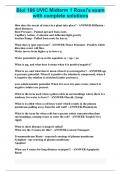
-
Biol 186 UVIC Midterm 1 Rossi-s exam with complete solutions
- Exam (elaborations) • 6 pages • 2024
-
- $9.49
- + learn more
four major classes in the molecules of life 1. Lipids 2. Carbohydrates 3. Proteins 4. Nucleic Acids monomers "building block" molecules of a polymer Previous Play Next Rewind 10 seconds Move forward 10 seconds Unmute 0:00 / 0:15 Full screen Brainpower Read More polymers many monomers covalently linked together dehydration how polymers are synthesized hydrolysis how polymers are broken homopolymers polymers composed of identical monomers...

How did he do that? By selling his study resources on Stuvia. Try it yourself! Discover all about earning on Stuvia


